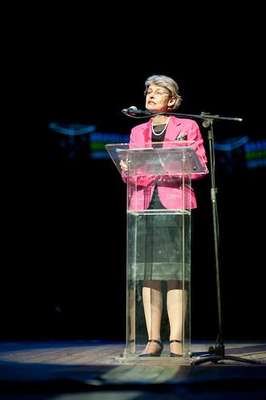
UNESCO總幹事波克娃在世界遺產委員會開幕式上致詞
【世界遺產中心特稿】
2010年7月26日星期一
刻正在巴西利亞舉行的世界遺產委員會,將對來自33個國家的登錄《世界遺產名錄》申報案件進行審議。3個是目前仍未有世界遺產地的國家,分別是馬紹爾群島、吉里巴斯與塔吉克。
聯合國教科文組織總幹事波克娃與巴西文化部長費雷拉,在巴西利亞時間7月25日星期日傍晚,共同宣布第33屆世界遺產委員會正式開議,此次會議將持續進行到8月3日。
在致詞當中,波克娃總幹事強調了世界遺產與世界發展的主要挑戰之間的關連性。「我確信此屆會議將能夠激發出新浪潮,」總幹事說:「各處遺產地可以嘗試能更接近相關社群的創新性保護措施,」以及「將實驗室中永續發展的具體成果付諸實施。」這是「聯合國教科文組織在這個「國際生物多樣化年」中一直不斷推動的訊息。」她說道。
巴西文化部長則疾言高呼「世界遺產無法以孤立的手段加以對待」的事實,而是應該成為國家發展整體規劃中不可或缺的一部分。他同時也強調了未來如何包容全世界無數文化型態以強化《世界遺產名錄》代表性的重要性。
今年共計有39處遺產地的提名申報案件,其中有8處自然遺產,29處文化遺產與2處自然與文化雙重遺產。當中有9處為現有世界遺產地的擴展項目申請。(版主按:另有2處原待審之遺產地業由申報國於近日主動撤回,分別是白俄羅斯/波蘭共同申報的「奧古斯托斯基運河-人與自然之傑作」與美國申報的「弗農山」。)
世界遺產委員會將對147處世界遺產地的保護狀況進行審視,其中也包括了列入《瀕危世界遺產清單》中的31處遺產地,以及另外36處遭到嚴重關切的遺產地。被列入瀕危清單的遺產地,表示它們正遭受各種不同的威脅,譬如污染、都市發展、對過度旅遊的管理不當、戰爭和自然災害等,這些威脅都將對列入《世界遺產名錄》的遺產地原所具備的「突出的普遍性價值」產生負面的影響。
世界遺產委員會是依據1972年《世界遺產公約》之實施而承擔具體職責,由締約國選舉產生的21個委員國所組成,委員國任期為4年。每一年,委員會都將決定登錄《世界遺產名錄》的遺產地。這些遺產地由締約國申報,在申請後由兩個協力國際組織予以審查-文化遺產由國際古蹟遺址理事會(ICOMOS)負責,自然遺產由國際自然保育聯盟(IUCN)負責,兩個組織會將他們的審查結果做成建議知會世界遺產委員會。另外,國際文物保護與修復研究中心(ICCROM)也在保護與修復技術訓練方面提供相關的專業諮詢。
世界遺產委員會同時也將審議已獲登錄的世界遺產地之保護情況報告,並要求締約國在必要時採行適當的保護與保存措施。委員會並負責監管每年從「世界遺產基金」撥發超過4百萬美元的經費,這些經費是為了達成緊急行動,專業訓練,以及鼓勵科技合作等多項目的。為了完成這些任務,聯合國教科文組織乃設置「世界遺產中心」作為世界遺產委員會的秘書機構。
直至目前為止,《世界遺產名錄》共列入了890處擁有「突出的普遍性價值」的遺產地,包括689處文化遺產,176處自然遺產與25處雙重遺產,分佈在148個締約國境內。
Thirty-nine properties to be considered for inscription on UNESCO’s World Heritage List
http://whc.unesco.org/en/news/634
Worlr Heritage Centre
Monday, July 26, 2010
Thirty-nine nominations from 33 countries will be considered for inscription on UNESCO's World Heritage List during the meeting of the World Heritage Committee underway in Brasilia. Three of the countries - Marshall Islands, Kiribati and Tajikistan - have no properties inscribed on the World Heritage List to date.
The Director-General of UNESCO Irina Bokova and Brazil's Minister of Culture João Luiz da Silva Ferreira formally opened the 34th session of the Committee here on the evening of Sunday 25 July. The meeting continues through to 3 August.
In her opening address, Irina Bokova stressed the link between heritage and the world's major development challenges. "I am convinced this Committee can blaze new trails," said the Director-General. "Sites can be testing grounds for innovative protective measures that closely involve communities" and "real laboratories of sustainable development in practice." This is a "message that UNESCO is promoting throughout this International Year of Biodiversity," she said.
The Minister of Culture of Brazil hailed the fact that "heritage is no longer treated in an isolated way" but has become an integral part of national development planning. He also underscored the importance of further improving the representativity of the world's myriad cultures on the World Heritage List.
The 39 nominations submitted this year include 8 natural, 29 cultural and 2 mixed (i.e. both natural and cultural) properties, as well as 9 extensions to properties already listed (see list below).
The Committee will also review the state of conservation of 147 World Heritage properties, including the 31 sites inscribed on the List of World Heritage in Danger and another 36 that are causing serious concern. The In Danger List features sites which are threatened by a variety of problems such as pollution, urban development, poorly managed mass tourism, wars and natural disasters, which have a negative impact on the outstanding values for which the sites were inscribed on the World Heritage List.
The World Heritage Committee, responsible for the implementation of the World Heritage Convention, comprises representatives of 21 countries, elected by the States Parties for four years. Each year, the Committee adds new sites to the List. The sites are proposed by the States Parties. Applications are then reviewed by two advisory bodies: cultural sites by the International Council on Monuments and Sites (ICOMOS), and natural sites by the International Union for Conservation of Nature (IUCN), which inform the Committee of their recommendations. The International Centre for the Study of the Preservation and Conservation of Cultural Heritage (ICCROM) provides expert advice on conservation and training in restoration techniques.
The World Heritage Committee also examines reports on the state of conservation of inscribed sites and asks States Parties to take appropriate conservation and preservation measures when necessary. The Committee supervises the disbursement of over $4 million annually from the World Heritage Fund, aimed, among other purposes, at emergency action, training of experts and encouraging technical cooperation. UNESCO's World Heritage Centre is the Secretariat of the World Heritage Committee.
To date, the World Heritage List recognizes 890 properties of "outstanding universal value," including 689 cultural, 176 natural and 25 mixed properties in 148 States Parties.


 留言列表
留言列表
